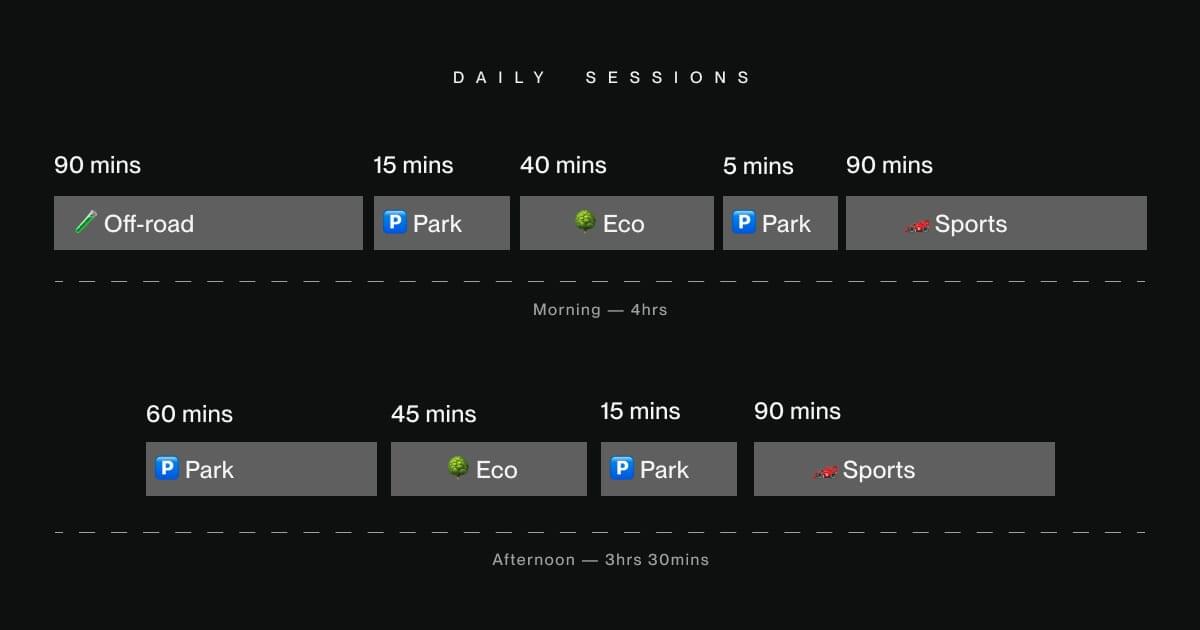Leverage Your Golden Hours to Tackle Tasks by Cognitive Effort

Most people think time management is hard:
- Too many tasks
- Not enough time
- Easily distracted
- Struggle to prioritise
- Feeling overwhelmed
I’ve run a profitable web design agency for 14 years.
During that time, I have worked with clients around the globe. Running a business means lots of different tasks. I have spent a lot of time, money and energy figuring out how to manage my day effectively.
In fact, I have invested so many hours into mastering my time that I have created a framework called Focus Drivers.
But do you want to know a secret?
I use the same 5 steps every day. And I’m sharing them with you.
Step 1: Assign tasks a cognitive effort
One of the biggest mistakes I see with productivity is planning your day with a single list of tasks.
Instead, group tasks by cognitive effort.
Here’s how it works:
- 4 focus modes to categorise every task
- When you add a task to your task manager of choice, tag it with the relevant Focus Driver mode.
- Tag by the cognitive effort. Some emails, calls, Zooms are quick and easy. Others require deep focus. Tag accordingly.
- If you can’t choose only one mode, then your task is too broad. Break it down to smaller steps.
The Focus Driver modes

🅿️ Park
- 5-90 minutes
- Shed mental focus
- Switch off and relax
🧪 Off-road
- Deep focus
- 30-60 minutes
- No interruptions
- High cognitive tasks
- Gain new knowledge
🏎️ Sports
- Deep focus
- 30-60 minutes
- No interruptions
- High cognitive tasks
- Use existing knowledge
🌳 Eco
- Shallow focus
- 5-60 minutes
- Allow interruptions
- Low cognitive tasks
This simple step allows you to clarify the type of focus and effort required for every action you take. You know what mode is needed to approach any task.
Step 2: Assess capability and responsibility
Here’s how:
- Responsibility: What must be done today?
- Capability: What are you best suited to do?
- Predictability: What are your golden hours today?
Your golden hours are how you leverage your body’s natural rhythm to create a focused and energised daily routine.

ultradian-rhythm-and-circadian-rhythm.jpeg
Are you an early bird? Or do the sparks of creativity arrive in the evening?
Consider the times when you are:
- Most focused
- Easily distracted
- Easily interrupted
- Tired and out of energy
- Energised and work feels effortless
- Excited to learn, explore or try something new
Quick note: Don’t think in minutes. Think in phases. For example, early morning, before lunch, after lunch, late afternoon, etc.
Step 3: Group tasks into focus sessions
This is not about grouping similar tasks like email, phone calls or meetings.
Some emails are critical and need deep focus. Others can be done with little effort. Likewise, some meetings are to gain knowledge (learn). Others may use your existing skills (teach).

An example daily plan by focus modes
You’ve already assigned tasks to a Focus Driver. Now you combine tasks into sessions.
Here’s how it works:
- Avoid doing random tasks one after another
- Instead, group tasks together to form focused sessions
- Sessions are approx. 30-60 minutes
- Space multiple high-effort (SPORTS or OFF-ROAD) sessions 2-3 hours apart
Easy, right?
Quick note: Make sure you have PARK-related tasks planned into your day. You’ll use them in Step 5. PARK mode should be used for all those restful moments that help recharge you mentally and shed focus!
Everyone has different ways to unwind. Find yours and plan it.
Step 4: Start your first session
Let’s do this:
- Start your first Focus Driver session
- Max 60-minute session
- Take micro-breaks every 30 minutes
- Follow the guidance around interruptions for that mode
- Set a timer and get to work
Tip: Micro-breaks can be 30-120 seconds. Think about anything other than the task you were working on.
Bonus tip: Mental focus follows visual focus. Stare at a point on a wall or screen for 30-60 seconds before starting the session. This adds “top-down” attentional engagement and reflects the neurotransmitters in the brain. More
Step 5: Rest and assess your future capability
Use PARK mode tasks to shed mental focus.
Research suggests that the Default Mode Network [“DMN”] is active when the brain is not focused on a specific task and plays a role in thinking about the past, the present and the future.
You can improve cognitive function and self-awareness through intentional downtime by activating the DMN. This leads to better decision-making and the ability to imagine creative solutions. The DMN also helps you empathise with other people’s thoughts, improving team understanding and cohesion.
Rest allows ideas to percolate in your subconscious.
View breaks like a stage change in a play. Your brain needs to have a short intermission while it moves the pieces of mental furniture around.
Before you begin your next Focus Drivers session, ask:
- Am I still capable of the mode I have planned next?
- Should I switch to a different mode?
The beauty of tagging tasks with Focus Drivers; is that even if you need to switch modes — you won’t have to think about what you should do next.
That’s it!
Now you know how to:
- Assign tasks a cognitive effort
- Assess capability and responsibility
- Group tasks into focus sessions
- Start your first session
- Rest and assess your future capability
All Articles